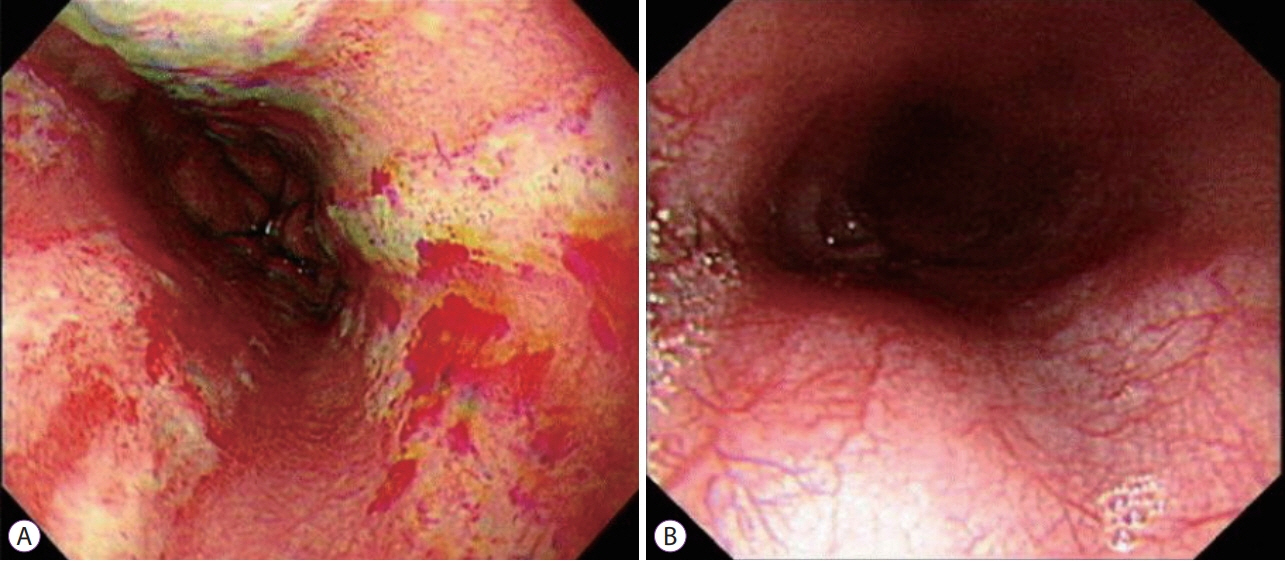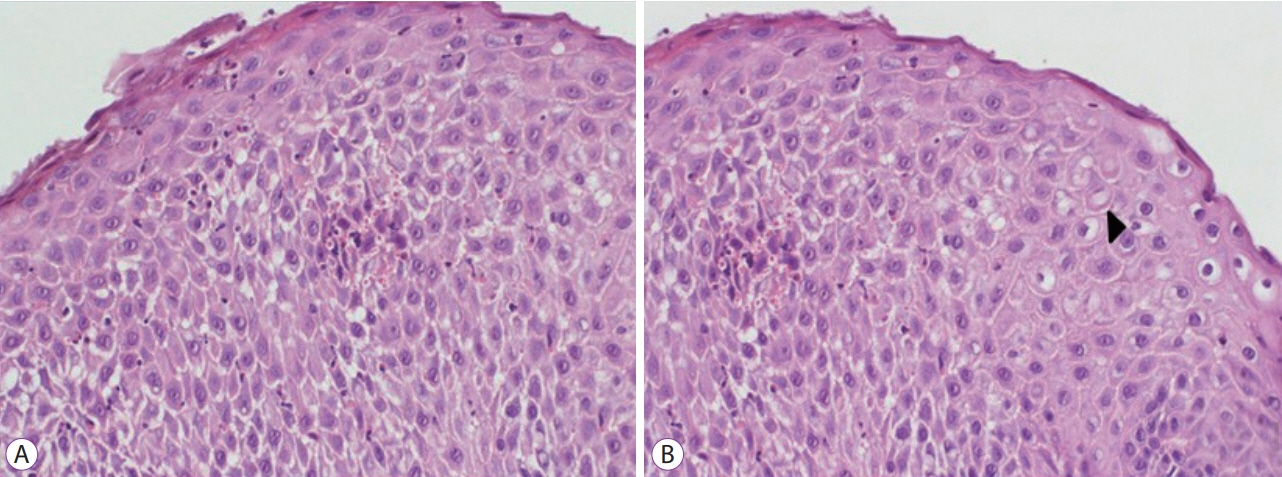Clin Endosc.
2020 May;53(3):366-369. 10.5946/ce.2019.066.
Corrosive Esophageal Injury due to a Commercial Vinegar Beverage in an Adolescent
- Affiliations
-
- 1Department of Pediatrics, Hanyang University, College of Medicine, Seoul, Korea
- 2Department of Pathology, Hanyang University, College of Medicine, Seoul, Korea
- KMID: 2502773
- DOI: http://doi.org/10.5946/ce.2019.066
Abstract
- Although gastroesophageal damage is commonly induced by accidental drinking of a strong acid or alkali, damage due to the consumption of a vinegar beverage is not well known. We report a case of corrosive esophageal ulcer found in an adolescent consuming a vinegar drink daily. A 15-year-old male visited the emergency room presenting with hematemesis and severe epigastric pain. Multiple longitudinal ulcers, concurrent mucosal hemorrhage, and denuded mucosa were noted in the whole of the esophagus via an endoscopic examination. He had been drinking a vinegar beverage daily without sufficient dilution. The patient was treated with corticosteroid, antibiotic therapy, and mucosa protecting alginate medication and was asked to fast for a week. The follow-up endoscopy showed improvement of the esophageal injuries. Overall, continuous consumption of a vinegar beverage can result in acidic burns and destruction of the surface of the upper gastrointestinal tract. Therefore, vinegar beverages should be considered as corrosive agents.
Keyword
Figure
Reference
-
1. Hill LL, Woodruff LH, Foote JC, Barreto-Alcoba M. Esophageal injury by apple cider vinegar tablets and subsequent evaluation of products. J Am Diet Assoc. 2005; 105:1141–1144.
Article2. Chung CH. Corrosive oesophageal injury following vinegar ingestion. Hong Kong Med J. 2002; 8:365–366.3. Bunick CG, Lott JP, Warren CB, Galan A, Bolognia J, King BA. Chemical burn from topical apple cider vinegar. J Am Acad Dermatol. 2012; 67:e143–e144.
Article4. De Lusong MAA, Timbol ABG, Tuazon DJS. Management of esophageal caustic injury. World J Gastrointest Pharmacol Ther. 2017; 8:90–98.5. Mamede RC, de Mello Filho FV. Ingestion of caustic substances and its complications. Sao Paulo Med J. 2001; 119:10–15.
Article6. Homan M, Orel R, Liacouras C. Caustic ingestion: a possible cause of eosinophilic esophagitis? Pediatrics. 2013; 131:e1284–e1287.
Article7. Anderson KD, Rouse TM, Randolph JG. A controlled trial of corticosteroids in children with corrosive injury of the esophagus. N Engl J Med. 1990; 323:637–640.
Article8. Howell JM, Dalsey WC, Hartsell FW, Butzin CA. Steroids for the treatment of corrosive esophageal injury: a statistical analysis of past studies. Am J Emerg Med. 1992; 10:421–425.
Article9. Usta M, Erkan T, Cokugras FC, et al. High doses of methylprednisolone in the management of caustic esophageal burns. Pediatrics. 2014; 133:E1518–E1524.
Article10. Yokota K, Uchida H, Tanano A, et al. Steroid pulse therapy prevents restenosis following balloon dilatation for esophageal stricture. Pediatr Surg Int. 2016; 32:875–879.
Article11. Divarci E, Celtik U, Dokumcu Z, Ozcan C, Erdener A. The efficacy of intralesional steroid injection in the treatment of corrosive esophageal strictures in children. Surg Laparosc Endosc Percutan Tech. 2016; 26:e122–e125.
Article12. Arunachalam R, Rammohan A. Corrosive injury of the upper gastrointestinal tract: a review. Archives of Clinical Gastroenterology. 2016; 2:56–62.13. Kochhar R, Poornachandra KS, Puri P, et al. Comparative evaluation of nasoenteral feeding and jejunostomy feeding in acute corrosive injury: a retrospective analysis. Gastrointest Endosc. 2009; 70:874–880.
Article14. Kluger Y, Ishay OB, Sartelli M, et al. Caustic ingestion management: world society of emergency surgery preliminary survey of expert opinion. World J Emerg Surg. 2015; 10:48.
Article
- Full Text Links
- Actions
-
Cited
- CITED
-
- Close
- Share
- Similar articles
-
- Corrosive Injury Due to Edible Vinegar
- Difficulty of balloon dilatation in corrosive esophageal strictures
- A Clinical Observation on Children with Corrosive Esophagitis
- Esophageal Perforation Due to Pneumatic Pressure of Carbonated Beverage: Report of two cases
- Mucosal Resection in the Corrosive Esophageal Stricture: A new technique




